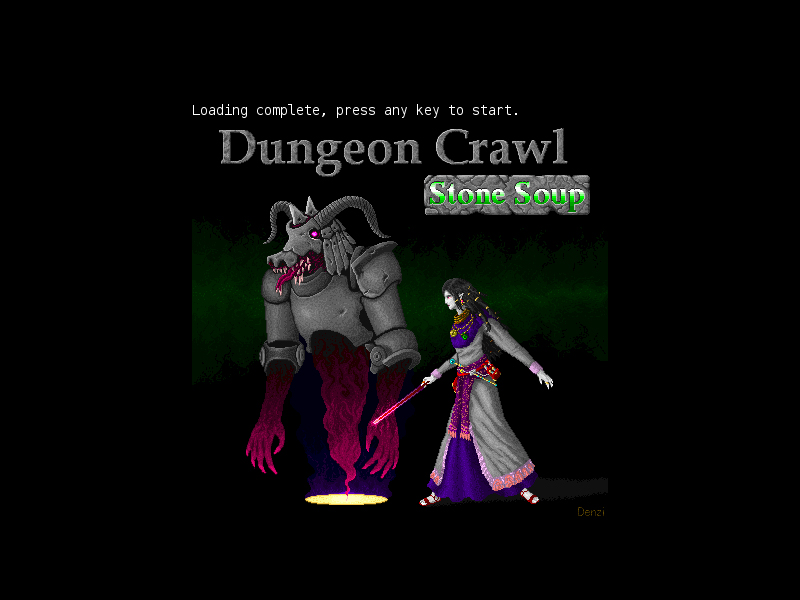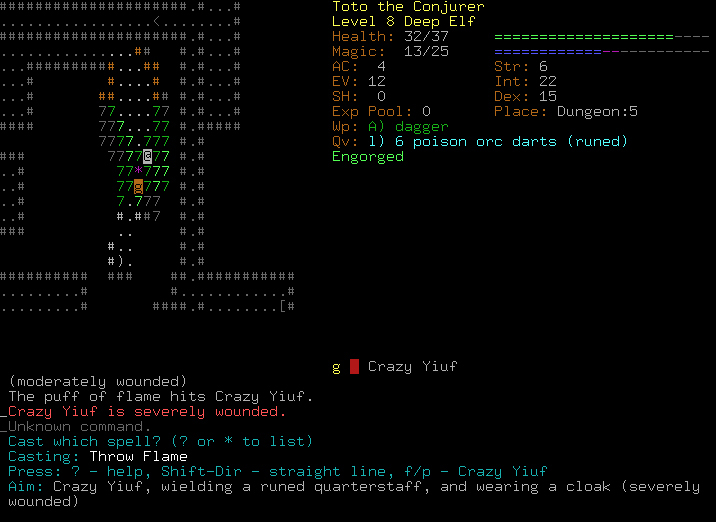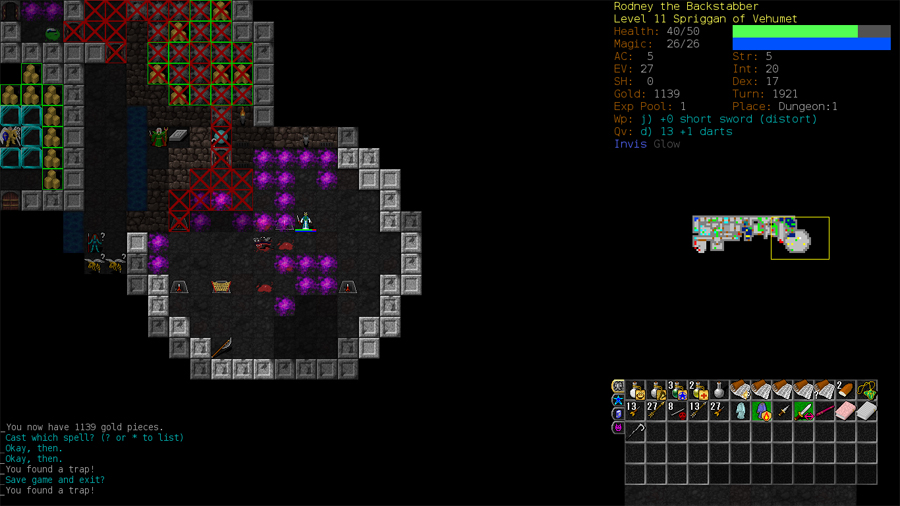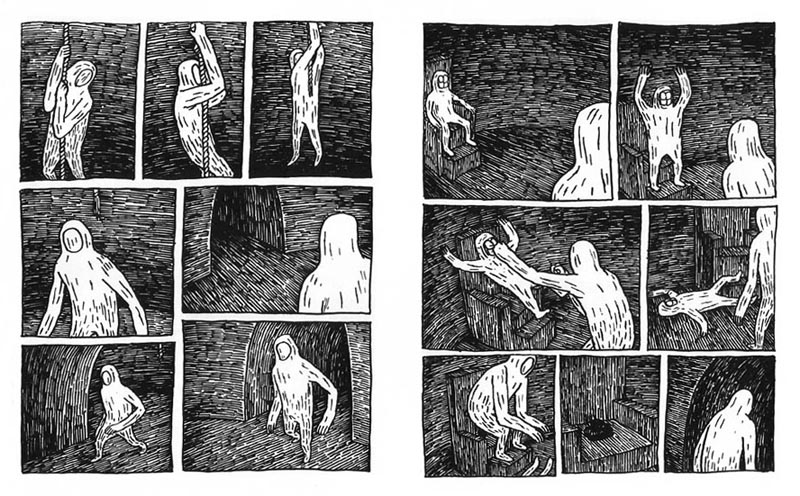Sorry, the comment form is closed.
It’s less than two weeks before my wedding, so of course I’ve become addicted to an ever-changing fantasy action RPG with a massive online community. I’m not talking about World of Warcraft – I’m talking about the free, cross-platform, and open-source roguelike Dungeon Crawl Stone Soup.
Dungeon Crawl Stone Soup title screen
For those of you unfamiliar with the video game genre of roguelike (as I was before I came across the term on a tumblr of video game concept sketches called Gamestorm), a roguelike is a game where you pick a species, job, and in some cases religion, and then try to get as far down as you can in a procedurally generated dungeon of monsters to retrieve a mystical object of power. There are two major design characteristics that all roguelikes share. The first is permadeath: although you can save progress as you travel downwards (to get data for troubleshooting bugs or to eat some pizza), when you die, you lose all your save files and any progress you made in terms of dungeon depth, character stats (characters become more powerful the more you battle), and items collected. The second is that each game is different: not only can you be walking through a standard stone dungeon your first game, a forest the next, and an icy beach the third; but also items don’t function the same from game to game. A green, bubbling potion that increases your health one game may poison or mutate you the next.
A trait that many roguelikes share, because of their origins on non-graphic UNIX terminals in the 80s (you can read a more detailed history of the first roguelike, a game called Rogue, here), is ASCII art.
Dungeon Crawl Stone Soup ASCII art mode
However, because I like at least some visuals, I play Dungeon Crawl Stone Soup in tiles mode.
Dungeon Crawl Stone Soup tiles mode
Ultimately, however, the graphics have nothing to do with whether or not a game is a roguelike. There are even roguelikes with isometric views or sophisticated 3d graphics, like in the not quite roguelike Diablo.
The experience that playing Dungeon Crawl Stone Soup most reminds me of is reading comics by Mat Brinkman or Brian Chippendale. Now, I know that it’s old hat by now to compare Fort Thunder comics to fantasy adventure video games (I read it first and most eloquently from Tom Spurgeon here), but before I played Dungeon Crawl Stone Soup I thought that Spurgeon was referring to the NES Legend of Zelda. Now I understand that he was really referring to roguelikes. Much more than the Zelda series, Dungeon Crawl Stone Soup is concerned with mutations, death, violence, and bodily functions. Much of my playing revolves around finding something for my character to eat, mostly corpses of the monsters I’ve slaughtered but sometimes I come across a sweet pear or a crunchy chayote. The Zelda series has never included such a mundane playing feature, but it’s that same mix of daily life and fantasy that give the Fort Thunder comics so much appeal.
Two pages from Oaf by Mat Brinkman
This comparison of Fort Thunder and roguelikes has given me an idea: does anyone out there want to collaborate on a procedurally generated webcomic? You code, I’ll draw the elements, and we can design the thing together. Imagine – at the beginning, you assemble and name your protagonist from a variety of heads, arms, torsos, and legs. You could even give them a weapon. Then they go through a random series of adventures that end in either death or glory, let’s say at least 10,247 different combinations. The tagline could be “It’ll be a different experience each time you click the Next button!” Or is this idea too hybrid, like a motion comic? Or does it already exist?





I love your ideas here and I’d definitely read a procedurally generated roguelike comic.
I think a lot about the relationship between gaming and drawing/comic making. They can be similar things in that drawing can be a form of “playing”. Did you ever make drawings that look sort of like a platform game, with pitfalls and spikes and a treasure at the end, and then make a friend “play” your drawing by pretending to be a character who has to move through the obstacles? I did a lot of that as a kid. Most of the drawing I did as a kid had to do with video games.
I’m feeling a little unoriginal after reading your post, especially the stuff about Brinkman’s Oaf (which I haven’t read but now wish I had a copy of!) because I just recently started a comic in which I basically “play” a character in a world that follows adventure-game logic. I do think what I’m up to is a little different and plan to keep going with it, but it’s not the revolutionary idea I thought it was until about 20 minutes ago. Thanks for humbling me a little, I appreciate it.
Also, coincidentally, I have been thinking about the possibility of outside participation by asking other artists “choose” a character by drawing their version of my first panel, picking their character, and letting them explore the world in comic form. So, if you want a little project to work on…
Comment by saman — February 15th, 2011 @ 7:52 pm
Yeah I think there are a lot of similarities between games and comics. I never made drawings like you’re talking about, but they sound awesome. I do remember playing a drawing game where you would start, draw a figure, then the next person who draw a missile destroying it, then the first person would draw a monster snatching the rocket from the sky, and we would pass the same drawing back and forth making it more and more complicated. Fun times.
You should definitely read Oaf, it’s amazing. I just read your comic, I dig it d00d! I think there’s plenty of territory to explore in adventure-style comics even if Brinkman and Chippendale kind of staked out the territory first (otherwise I wouldn’t be drawing comics at all).
I’m pretty busy at the moment with my own projects but that sounds like a kewl idea, I’d love to see the results!
Comment by Mark P Hensel — February 19th, 2011 @ 1:10 am
Glad you like the comic. Still have a long way to go with it. I’m definitely still learning how to make comics.
Haha, so about reading Oaf. I take it it’s in Teratoid Heights: http://www.amazon.com/gp/product/0966536320/ref=olp_product_details?ie=UTF8&me=&seller=
Only 350 bucks…Not going to happen.
That REALLY makes me want to find a copy of the story to read though.
At least I have Multiforce.
Comment by saman — February 22nd, 2011 @ 6:52 pm
Hey Saman,
Yeah Oaf is in Teratoid Heights. Here are some cheaper copies: http://www.amazon.com/gp/offer-listing/B002IS8XEC/ref=dp_olp_used?ie=UTF8&qid=1298522649&sr=1-1&condition=used
It collects a bunch of Brinkman’s comics. I’m not sure if he did these before or after Multiforce.
Comment by Mark P Hensel — February 23rd, 2011 @ 11:45 pm
I think that is a great idea.
As these posts are rather old was wondering if you ever started one up?!
If so please send me the link.
My comic has been heavily influenced by early dungeon crawl games.
Give it a read if you fancy.
Cheers,
Brando
Comment by Brandobaris — November 22nd, 2013 @ 5:11 am
Hi Brando,
I still haven’t made a procedurally generated comic but I am working on a game… I might return to this idea eventually. I can see the dungeon crawl influence in your comic, you got some interesting ideas in there! I like the tone too…
Comment by William Cardini — February 27th, 2014 @ 5:26 pm
http://www.thecrawlcomic.com
Comment by Brandobaris — November 22nd, 2013 @ 5:12 am